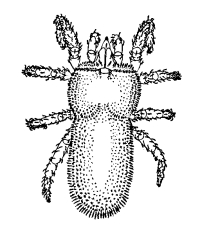Harvest mite
(Neotrombicula autumnalis)

Biology:
Harvest mites are very small orange-red creatures, which are up to 0.3 mm long and have 6 legs as larvae and 8 as adults. They are part of the arachnid class.
Harvest mites start as eggs, then go on to become larvae before going through various nymph stages and then finally becoming adults.
In warm, humid and sunny weather, the larvae hatch from the eggs, which are laid on the ground, then they climb up the low vegetation and wait at a height of 5 to 20 cm for a potential host.
Their hosts are usually birds and small rodents, but also dogs, cats and humans, which wipe them off the grass, for example.
Like ticks, they seek out moist and warm areas with thin skin. They scratch the skin with their mouthparts and secrete saliva, which dissolves the tissue. They therefore feed mostly on cell fluid and lymph. Only rarely do they breach a blood vessel and then ingest the blood. After drawing, they fall off and develop over three nymph stages into adult creatures. These adults are not parasitic and inhabit the soil. Humans are actually not ideal hosts for the creatures. As a result, they only draw here for relatively short periods of time and release themselves again quickly after being picked up outside and brought into the dwelling. They can therefore often be found there in the dust on the flooring.
Damage:
Harvest mites primarily agglomerate outdoors on late summer days. Only their larvae feed on humans and animals – the imagines are not parasitic!
When they draw fluids, they cause unpleasant itchy rashes (harvest mite bites, also known as “harvest itch” or trombidiasis). The itching can be particularly unbearable in the warmth of your bed.
